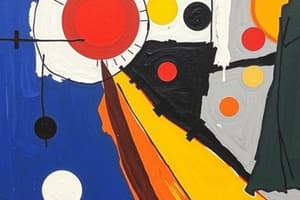Podcast
Questions and Answers
¿Dónde nació Wassily Kandinsky?
¿Dónde nació Wassily Kandinsky?
- Moscú, Rusia (correct)
- Múnich, Alemania
- Tbilisi, Georgia
- Alemania
¿Qué elemento es una característica recurrente en las pinturas de Kandinsky?
¿Qué elemento es una característica recurrente en las pinturas de Kandinsky?
- Personas y retratos realistas
- Formas geométricas como círculos y triángulos (correct)
- Árboles y paisajes naturalistas
- Animales exóticos y figuras mitológicas
¿En qué ciudad se estableció Kandinsky para estudiar arte bajo Anton Ažbe?
¿En qué ciudad se estableció Kandinsky para estudiar arte bajo Anton Ažbe?
- Múnich (correct)
- Berlín
- Tbilisi
- Moscú
¿Qué contribución principal hizo Kandinsky al arte moderno?
¿Qué contribución principal hizo Kandinsky al arte moderno?
¿Qué tipo de formas solía utilizar Kandinsky en sus pinturas abstractas?
¿Qué tipo de formas solía utilizar Kandinsky en sus pinturas abstractas?
¿Cuál de los siguientes movimientos artísticos ha sido asociado con las obras de Kandinsky?
¿Cuál de los siguientes movimientos artísticos ha sido asociado con las obras de Kandinsky?
¿Cómo definía Kandinsky el arte abstracto?
¿Cómo definía Kandinsky el arte abstracto?
¿Qué influencia tuvo la teoría del color en las obras de Kandinsky?
¿Qué influencia tuvo la teoría del color en las obras de Kandinsky?
¿Qué técnica destacaba Kandinsky al crear arte abstracto?
¿Qué técnica destacaba Kandinsky al crear arte abstracto?
¿Qué doctrinas se consideran precursoras en las obras de Kandinsky?
¿Qué doctrinas se consideran precursoras en las obras de Kandinsky?
¿Qué relación establecía Kandinsky entre los colores?
¿Qué relación establecía Kandinsky entre los colores?
¿Cómo se destacó Kandinsky en su enfoque hacia la creación artística?
¿Cómo se destacó Kandinsky en su enfoque hacia la creación artística?
Flashcards are hidden until you start studying
Study Notes
Wassily Kandinsky
Wassily Kandinsky was born on December 4, 1866, in Moscow, Russia. He is considered one of the pioneers of abstract art due to his significant contributions to modern painting. This renowned artist's impact extends beyond Russian culture; he is celebrated globally for his unique interpretations of color, form, and symbolism.
Early Life and Career
Kandinsky experienced a diverse upbringing. His father was a wealthy cloth merchant from Tbilisi, while his mother was a German-born soprano singer who died when Wassily was only seven years old. He studied law before moving to Munich in 1896 to study art under the tutelage of Anton Ažbe at the private Academy of Fine Arts. In 1911, Kandinsky moved back to Moscow and established a new school for young artists.
Geometric Shapes
As one of the first artists to experiment with non-representational forms, Kandinsky aimed to create pure abstraction by eliminating any trace of representational subject matter. However, later in life, he reintroduced elements of representation into his paintings without returning entirely to figurative art. One recurring theme in his work is geometric shapes such as circles, triangles, and squares. These shapes can often be found within the context of a field of simple colors.
Art Movement
Kandinsky's works have been associated with several art movements throughout history. They were initially linked to Impressionism and Expressionism before being categorized as part of the movement known as Abstraction. Some critics also view his works as attaining an early degree of abstraction, which they regard as a precursor to the development of Futurist, Constructivist, and Suprematist doctrines.
Abstract Art
Abstract art, as defined by Kandinsky himself, is "the visual language of colour, line, shape, etc., existing independently from external data". Kandinsky's approach to creating abstract art was groundbreaking for its time. Instead of using traditional painting techniques, he sought to convey emotions through color and shape combinations. He believed that colors could interact with each other like musical notes, producing harmonies, discords, and dissonances.
Color Theory
Kandinsky's understanding of color theory was deeply rooted in music. Like many musicians, he perceived colors as having different pitches, which he believed were affected by their hue and saturation. This unique perspective influenced his art, as he often used contrasting colors to create dynamic visual effects.
In conclusion, Wassily Kandinsky was a visionary artist who pushed the boundaries of what was possible in painting. His exploration of abstract forms, innovative use of color, and continued experimentation make him a pivotal figure in the history of modern art.
Studying That Suits You
Use AI to generate personalized quizzes and flashcards to suit your learning preferences.


